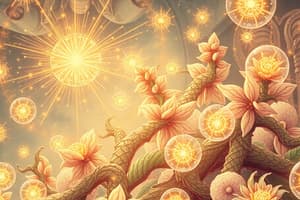Podcast
Questions and Answers
What is the main purpose of the light reaction?
What is the main purpose of the light reaction?
Provides energy for the dark reactions in the form of ATP and NADPH
What are the key components of the light reaction?
What are the key components of the light reaction?
- Two photosystems
- Thylakoid membrane
- Electron transport chain
- All of the above (correct)
Photosystem I is located at the inner surface of the grana thylakoid membrane.
Photosystem I is located at the inner surface of the grana thylakoid membrane.
False (B)
Photosystem II is associated with the photolysis of water.
Photosystem II is associated with the photolysis of water.
Which of the following statements is true about Photosystem II?
Which of the following statements is true about Photosystem II?
What is the role of the electron transport chain in the light reaction?
What is the role of the electron transport chain in the light reaction?
What is chemiosmosis and how is it related to the light reaction?
What is chemiosmosis and how is it related to the light reaction?
Explain the process of cyclic photophosphorylation.
Explain the process of cyclic photophosphorylation.
Explain the role of the enzyme ATP synthase in the light reaction.
Explain the role of the enzyme ATP synthase in the light reaction.
What is the role of Pheophytin in Photosystem II?
What is the role of Pheophytin in Photosystem II?
What is the role of plastoquinone in the light reaction?
What is the role of plastoquinone in the light reaction?
The oxygen produced in the light reaction comes from carbon dioxide.
The oxygen produced in the light reaction comes from carbon dioxide.
Flashcards
Light Reaction
Light Reaction
The phase of photosynthesis that converts light energy into chemical energy as ATP and NADPH.
ATP
ATP
A high-energy molecule generated during the light reactions, used for energy transfer.
NADPH
NADPH
An electron carrier produced in the light reactions, crucial for fueling the dark reactions.
Photosystems
Photosystems
Signup and view all the flashcards
Thylakoid Membrane
Thylakoid Membrane
Signup and view all the flashcards
Electron Transport Chain
Electron Transport Chain
Signup and view all the flashcards
Chemiosmosis
Chemiosmosis
Signup and view all the flashcards
Cyclic Photophosphorylation
Cyclic Photophosphorylation
Signup and view all the flashcards
Water-Plastoquinone Reductase
Water-Plastoquinone Reductase
Signup and view all the flashcards
Dark Reactions
Dark Reactions
Signup and view all the flashcards
Study Notes
Photosynthesis: Light Reaction
- The main purpose of the light reaction is to provide energy for the dark reactions in the form of ATP and NADPH.
- Two photosystems (PS II and PS I) and an electron transport chain are involved.
- This process occurs in the thylakoid membrane.
- Photosystem II (PS II) is located at the inner surface of the grana thylakoid membrane and contains a reaction center known as P680.
- Photosystem I (PS I) is positioned at the outer surface of the grana thylakoid membrane and contains a reaction center called P700.
- PS II is associated with water photolysis (splitting water into oxygen, protons, and electrons). This process produces ATP and NADPH.
- PS I participates in cyclic and non-cyclic photophosphorylation. However, it is primarily involved in non-cyclic reactions.
- The electron transport chain carries electrons from PS II to PS I, creating a proton gradient across the thylakoid membrane.
- ATP synthase uses the proton gradient to produce ATP from ADP and inorganic phosphate.
- NADP+ reductase uses electrons from PS I to reduce NADP+ into NADPH.
- The electron transport chain between PS II and PS I includes plastoquinone (PQ), cytochrome b6f complex, and plastocyanin (Pc).
- Water is oxidized to oxygen (O2) during the light-dependent reaction.
- Chemiosmosis is the process where the proton gradient drives ATP synthesis.
Photosystem I and Photosystem II (PS I vs PS II)
- PS I is located on the outer surface of the thylakoid membrane (non-appressed granal regions and stroma lamellae).
- PS II is positioned on the inner surface of the grana thylakoid membrane (appressed granal regions).
- The reaction centre of PS I is P700, and PS II is P680.
- The core complex of PS I includes a smaller number of proteins (~15 subunits) compared to the PSII core complex (~25-30 subunits).
- Pigments in PS I absorb longer wavelengths of light (>680 nm), while pigments in PS II absorb shorter wavelengths of light (<680 nm).
- PS I is rich in chlorophyll a and chlorophyll b. PS II is also rich in chlorophyll but chlorophyll b is more abundant.
- PS I is involved in both cyclic and noncyclic photophosphorylation, whereas PS II is only involved in noncyclic photophosphorylation.
- PS II is associated with water oxidation and is the source of electrons for the electron transport chain.
- PS II catalyzes water oxidation/photolysis.
Photosystem II (water-plastoquinone reductase)
- Water is split into oxygen, protons, and electrons in the lumen.
- Electrons are passed from water to plastoquinone (PQ).
- Plastoquinone is reduced to plastoquinol, taking up two protons.
- Plastoquinol carries electrons to the cytochrome b6f complex.
Studying That Suits You
Use AI to generate personalized quizzes and flashcards to suit your learning preferences.




